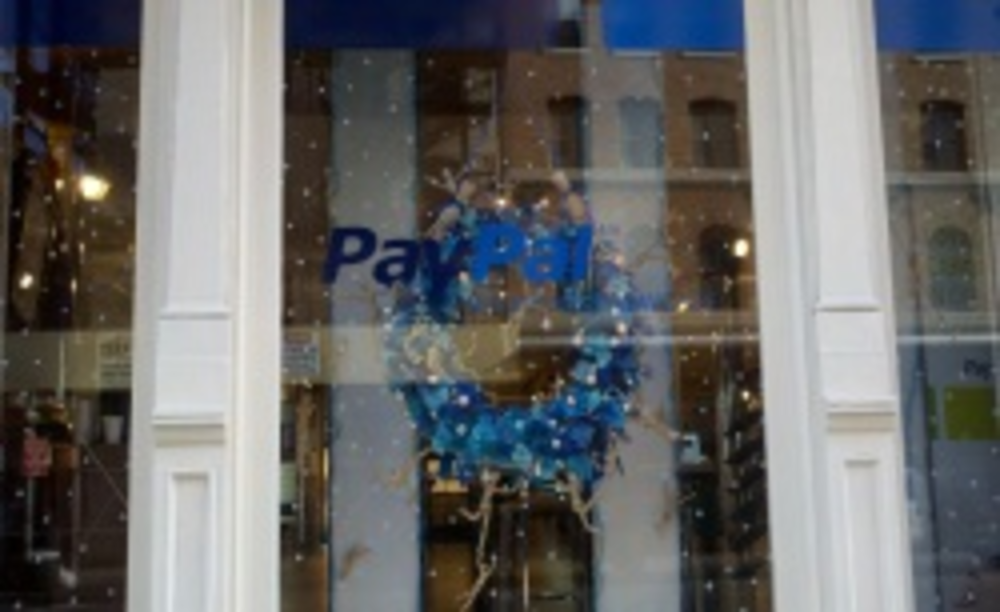PayPal invited me to check out the PayPal Shopping Showcase in downtown New York last Friday. The invite came while speaking to PayPal spokesperson Anuj Nayar last week for an article on PayPal’s mobile deals plans. Like a church choir, Nayar kept hammering the refrain that mobile deals was only part of PayPal’s bigger plans, that I’d have to come down to the Shopping Showcase to really see and understand the whole idea. Sure thing.
The PayPal Shopping Showcase is really a showcase of how brick-and-mortar merchants can take advantage of the forthcoming PayPal mobile wallet. The usage lifecycle spans from out-of-store acquisition to post-conversion retention and is pretty thorough in between. PayPal has their showcase organized into five different scenarios (living room, coffee shop, hardware store, grocery store and clothing store), but I’ll thread the handful of examples into one use case.
Say I’m at little kid’s birthday party and see a toy befitting my cousin, the hypothetical one whose present I’ve yet to purchase for his hypothetical birthday next week. I scan the product’s barcode via eBay-owned mobile app RedLaser, which then checks whether the product is in stock at a local toy store via eBay-owned Milo’s ability to access offline inventory.
Through the PayPal mobile app, I can put the product on hold or go ahead and purchase it for in-store pickup. Because the PayPal mobile wallet can include multiple debit and credit cards, gift cards, loyalty cards and even frequent flier miles, I can split my purchase across multiple payment sources and even call a mulligan by changing sources after I completed the transaction.
But the juicy part of the PayPal mobile wallet is the near-store and in-store capabilities. First let’s say the toy store I’m visiting to pick up the product is located in an outdoor shopping center and that I’ll pass a rival toy store on the way from the parking lot. If I’m opted in to PayPal’s mobile deals service, I can receive a geotargeted deal from the rival toy store, possibly even for the product I’d already purchased since the deals can be served according to my PayPal purchase history.
But maybe I’m very committed to the first toy store. So I go in there and head to the aisle featuring the chosen toy that I didn’t purchase or put on hold because I was feeling particular about choosing the perfect version of a mass-produced item. Now the toy retailer has me (more or less), but the toy manufacturer isn’t yet clear of the woods. Just as a rival toy store was able to target a deal to me based on my mobile device’s location, a rival toy manufacturer can harness eBay-owned location-based service Where’s ability to target me to within 7 feet of my actual location. Assuming that the toy manufacturer has partnered with PayPal for mobile deals and that the toy store has uploaded their store map to Where, the rival manufacturer can send me a deal for their product when I step into the aisle to grab the original product.
But I’m hard set on the original toy. Good thing too, because a toy store sales associate has already seen I’m in their store via the automatic check-in I’ve enabled on the PayPal app. Since the check-in can include information about me such as my name and photo, that associate can even approach me by name. They might even have viewed products I’ve put on my wishlist and are able to tell me about a relevant promotion that will go live the following week.
With the hard-sell completed and the product in hand, my participation is over, but the toy store can add the transaction to the opted-in profile they have on me through PayPal and use it to inform future marketing.
When the PayPal mobile wallet eventually launches, it will have a competitor in Google Wallet. I covered the Google Wallet announcement in May, so I feel like a have an equal grasp of each mobile wallet. Both can include various payment options such as gift cards or loyalty cards. Both have ties to a deals service. Both face an uphill climb for adoption.
Speaking with three years experience working retail in New York’s shopping hub SoHo, I’m not sure which mobile payment service I’d want to optimize for first if I had to choose. There are a lot of variables (a greeting card retailer may not service enough tech-savvy consumers to warrant the investment, whereas a youth-friendly brand may). But everything being equal except the services’ features, I’d lean toward PayPal. I’d want to hedge that bet because Google seems to always have something up their sleeve–or at least within reach–but the PayPal mobile wallet and associated ecosystem (geotargeted mobile deals, consumer profiles for merchants, access to offline inventory, etc.) seems more comprehensive for the retailer and seamless for the consumer.








